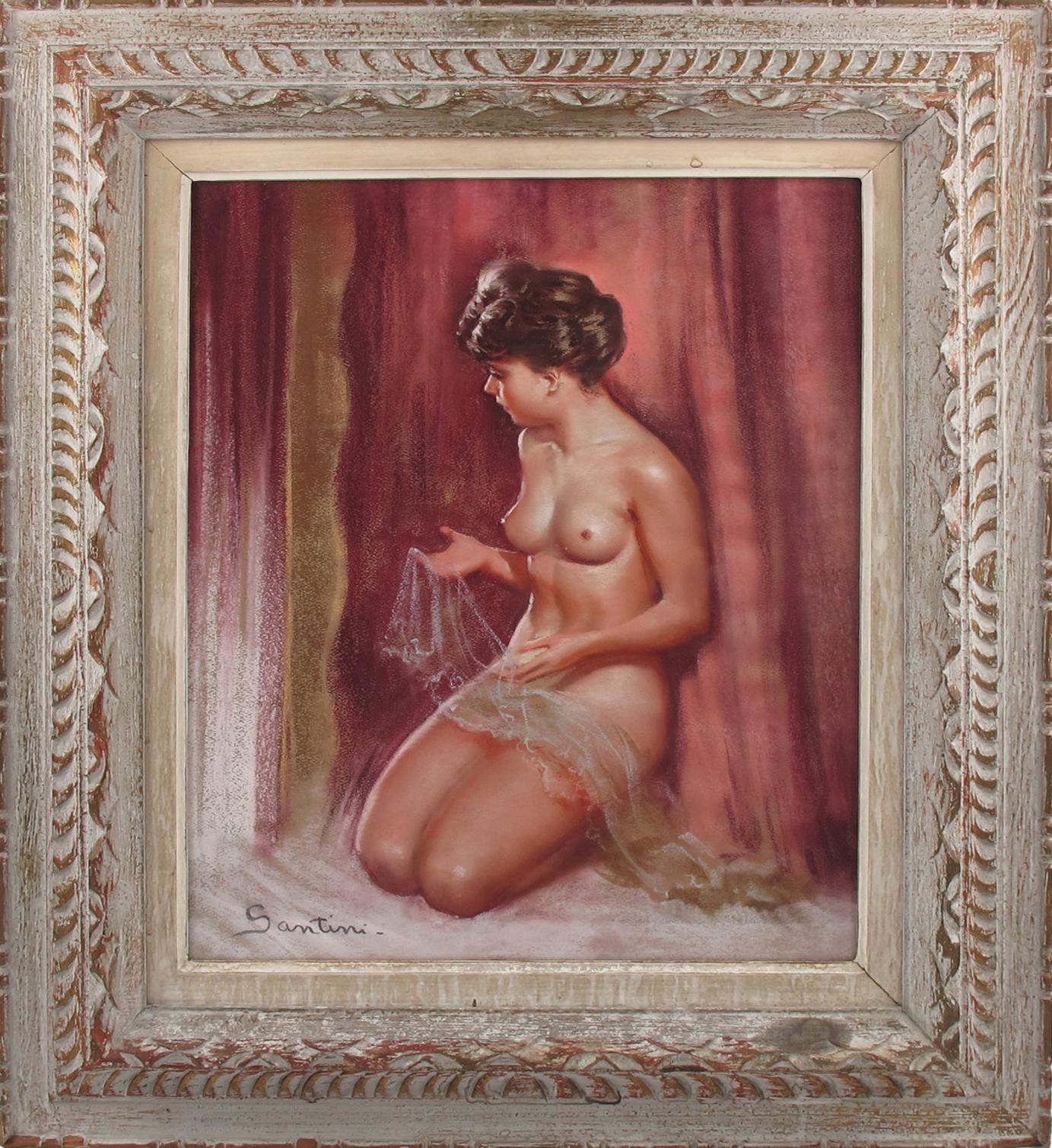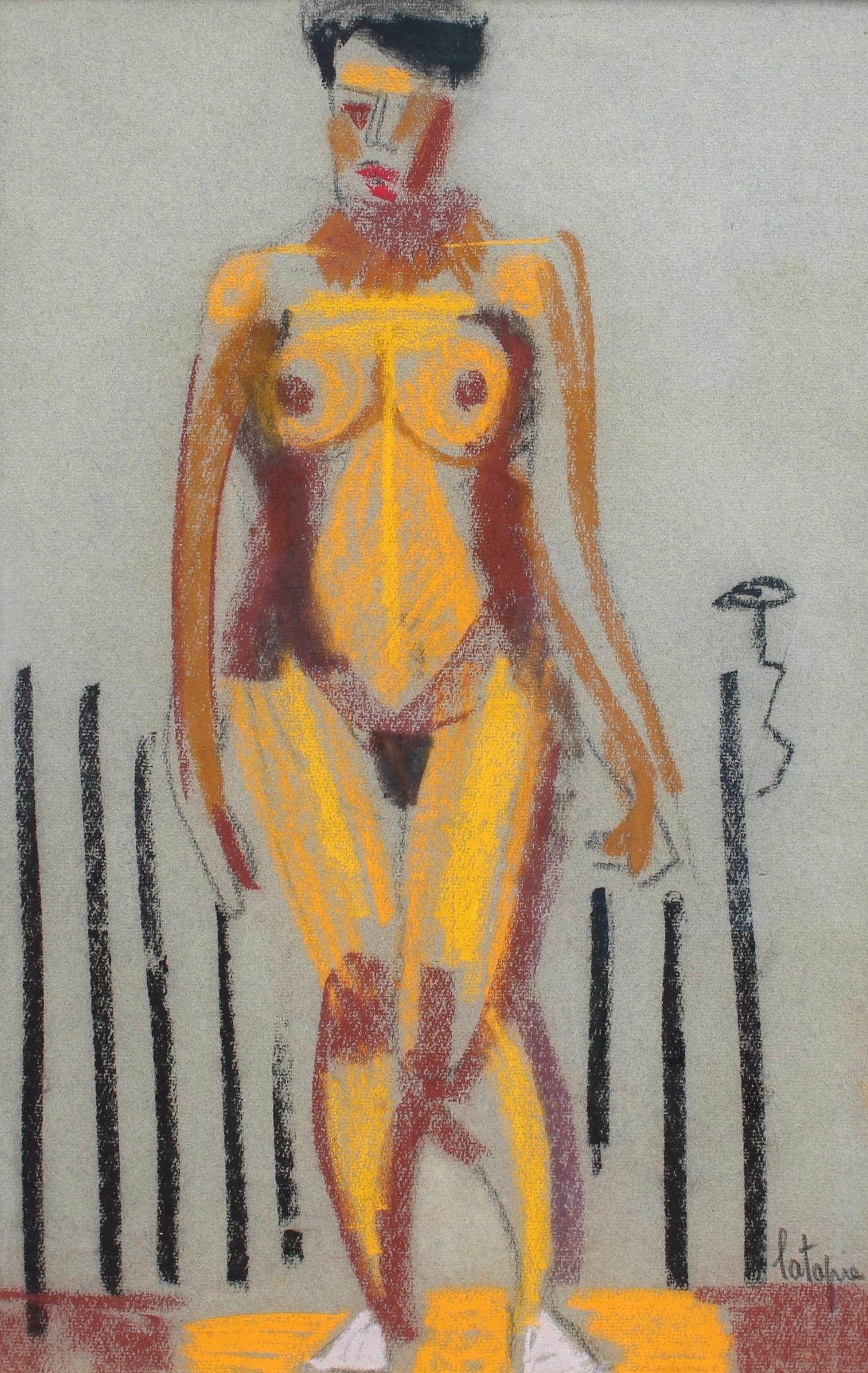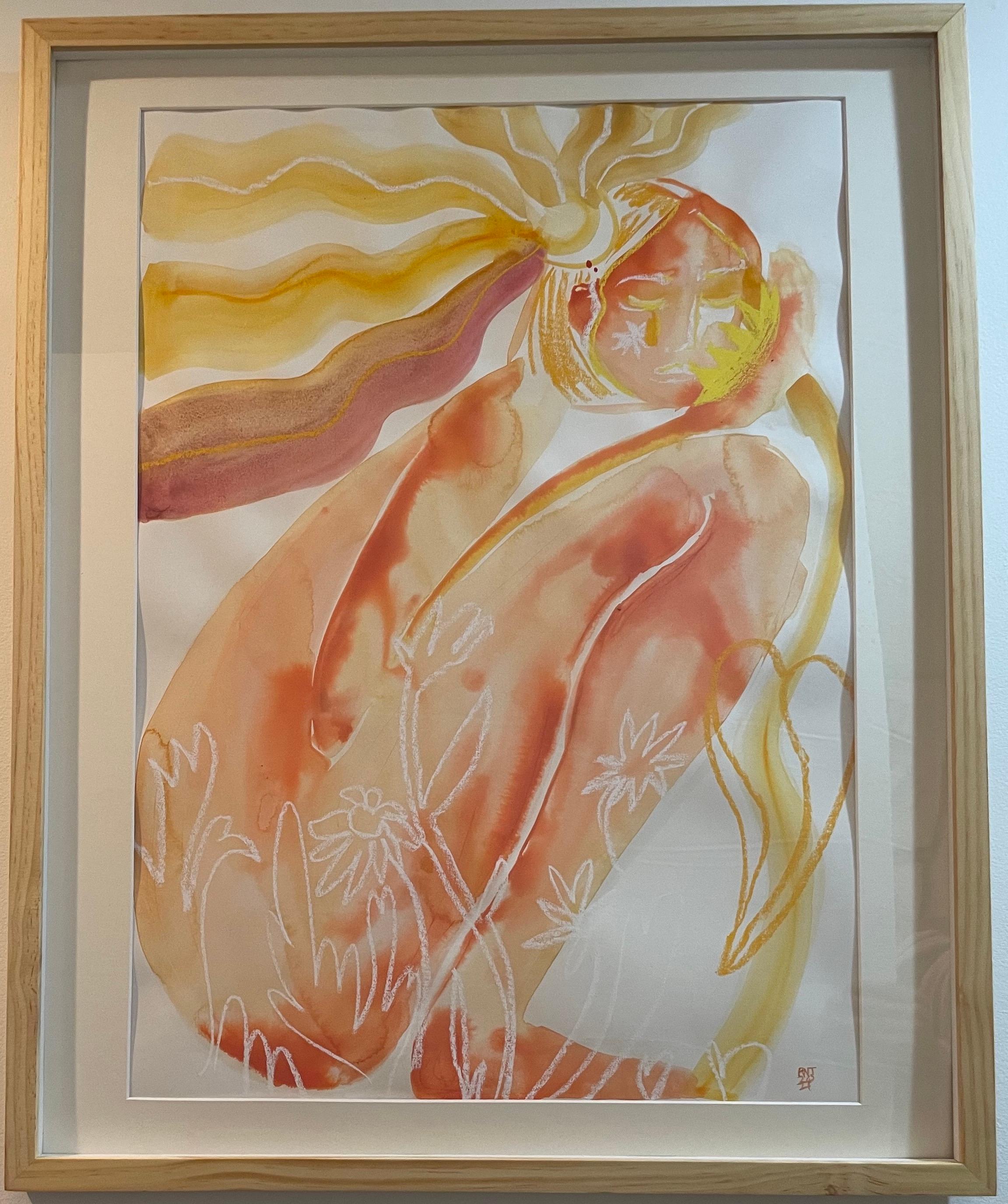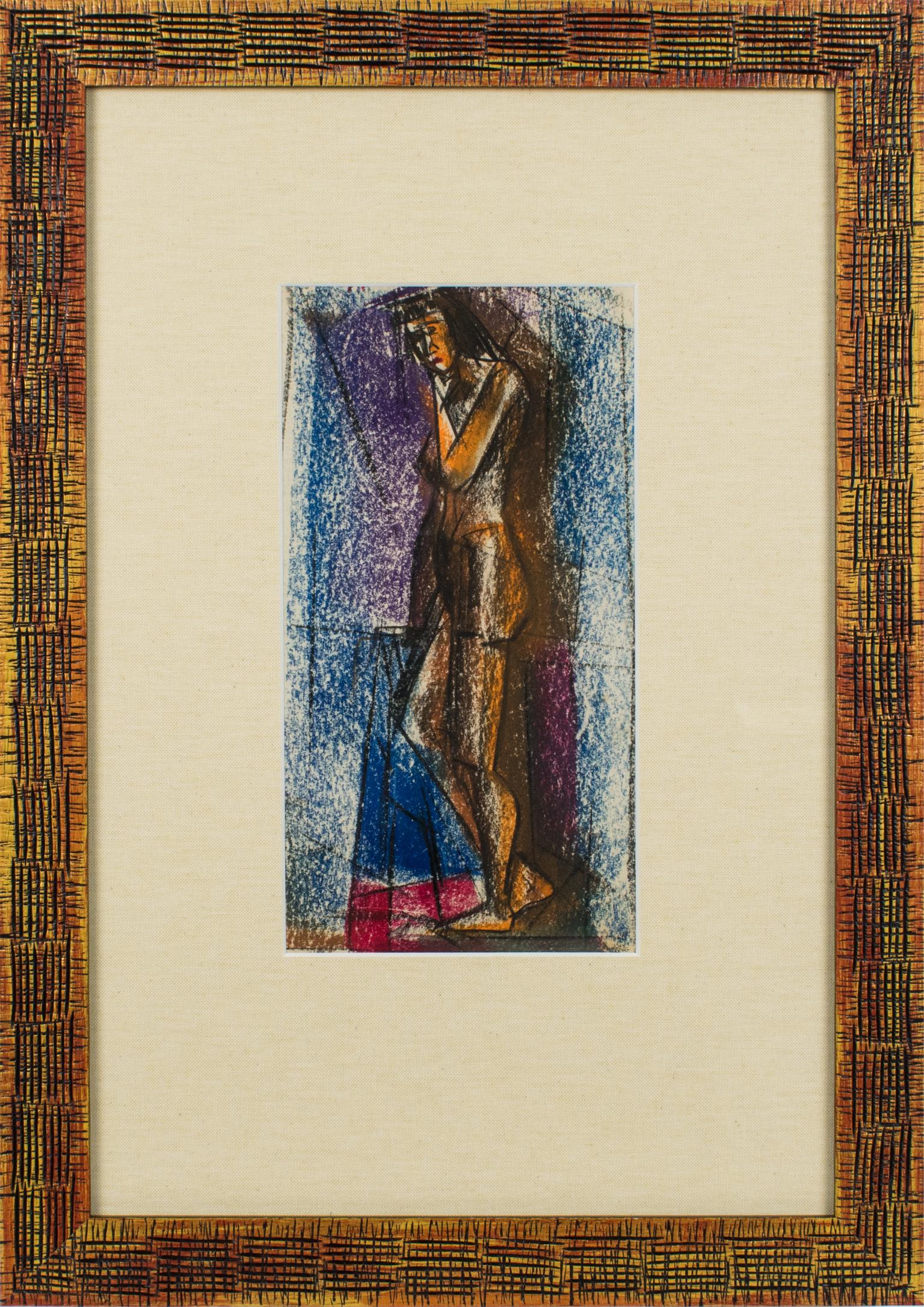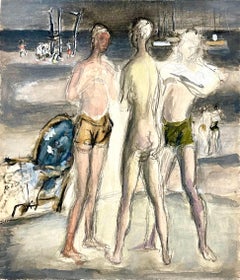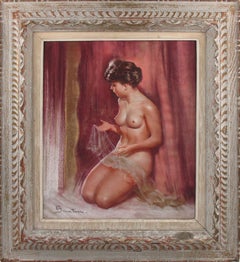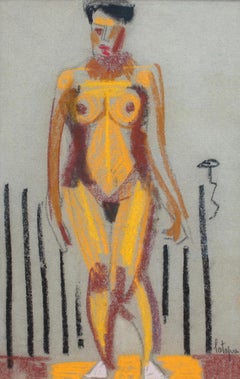Female Nude, Pastel Drawing After Renoir Polish Ecole D'Paris WPA Bezalel Artist
Want more images or videos?
Request additional images or videos from the seller
1 of 8
Jacques (Jakub) ZuckerFemale Nude, Pastel Drawing After Renoir Polish Ecole D'Paris WPA Bezalel Artistc.1930s
c.1930s
About the Item
- Creator:Jacques (Jakub) Zucker (1900-1981, American)
- Creation Year:c.1930s
- Dimensions:Height: 10 in (25.4 cm)Width: 12.75 in (32.39 cm)
- Medium:
- Movement & Style:
- Period:
- Condition:minor bending on edges.
- Gallery Location:Surfside, FL
- Reference Number:1stDibs: LU382638182
About the Seller
4.9
Platinum Seller
These expertly vetted sellers are 1stDibs' most experienced sellers and are rated highest by our customers.
Established in 1995
1stDibs seller since 2014
1,549 sales on 1stDibs
Typical response time: 1 hour
More From This SellerView All
- Female Nude, Pastel Drawing After Renoir Polish Ecole D'Paris WPA Bezalel ArtistBy Jacques (Jakub) ZuckerLocated in Surfside, FLJacques Zucker was born in 1900 in Radom, Poland. He was a notably famous Jewish American artist mostly known for his expressionist figure paintings. In his young years he traveled t...Category
20th Century Modern Nude Paintings
MaterialsPastel
- Simka Simkhovitch WPA W/C Painting Gouache American Modernist Beach Scene NudeBy Simka SimkhovitchLocated in Surfside, FLSimka Simkhovitch (Russian/American 1893 - 1949) This came with a small grouping from the artist's family, some were hand signed some were not. These were studies for larger paintings. This is a watercolor and gouache beach scene three young men bathing...Category
1930s American Modern Nude Paintings
MaterialsWatercolor, Gouache, Board
- Simka Simkhovitch WPA Artist Painting Gouache American Modernist Beach SceneBy Simka SimkhovitchLocated in Surfside, FLSimka Simkhovitch (Russian/American 1893 - 1949) This came with a small grouping from the artist's family, some were hand signed some were not. These were studies for larger paintings. Simka Simkhovitch (Симха Файбусович Симхович) (aka Simka Faibusovich Simkhovich) (Novozybkov, Russia May 21, 1885 O.S./June 2, 1885 N.S.—Greenwich, Connecticut February 25, 1949) was a Ukrainian-Russian Jewish artist and immigrant to the United States. He painted theater scenery in his early career and then had several showings in galleries in New York City. Winning Works Progress Administration (WPA) commissions in the 1930s, he completed murals for the post offices in Jackson, Mississippi and Beaufort, North Carolina. His works are in the permanent collections of the Dallas Museum of Art, the National Museum of American Art and the Whitney Museum of American Art. Born outside Kyiv (Petrograd Ukraine) into a Jewish family who owned a small department store. During a severe case of measles when he was seven, Simcha Simchovitch sketched the views outside his window and decided to become an artist, over his father's objections. Beginning in 1905, he studied at the Grekov Odessa Art School and upon completion of his studies in 1911 received a recommendation to be admitted to the Imperial Academy of Arts. Though he enrolled to begin classes in architecture, painting, and sculpture at the Imperial Academy, he was dropped from the school roster in December because of the quota on the number of Jewish students and drafted into the army. Simchovitch served as a private in the 175th Infantry Regiment Baturyn [ru] until his demobilization in 1912. Re-enrolling in the Imperial Academy, he audited classes. Simka Simkhovitch exhibited paintings and sculptures in 1918 as part of an exhibition of Jewish artists and in 1919 placed 1st in the competition "The Great Russian Revolution" with a painting called "Russian Revolution" which was hung in the State Museum of Revolution. In 1922, Simkha Simkhovitch exhibited at the International Book Fair in Florence (Italian: Fiera Internazionale del Libro di Firenze). In 1924, Simkhovitch came to the United States to make illustrations for Soviet textbooks and decided to immigrate instead. Initially he supported himself by doing commercial art and a few portrait commissions. In 1927, he was hired to paint a screen for a scene in the play "The Command to Love" by Fritz Gottwald and Rudolph Lothar which was playing at the Longacre Theatre on Broadway. Art dealers began clamoring for the screen and Simkhovitch began a career as a screen painter for the theater. Catching the attention of the screenwriter, Ernest Pascal, he worked as an illustrator for Pascal, who then introduced him to gallery owner, Marie Sterner. Simkhovitch's works appeared at the Marie Sterner Gallery beginning with a 1927 exhibit and were repeated the following year. Simkhovitch had an exhibit in 1929 at Sterner's on circus paintings. In 1931, he held a showing of works at the Helen Hackett Gallery, in New York City and later that same year he was one of the featured artists of a special exhibit in San Francisco at the California Palace of the Legion of Honor in Lincoln Park. The exhibit was coordinated by Marie Sterner and included four watercolors, including one titled "Nudes". He is of the generation of Russian Soviet artists such as Isaac Pailes, Serge Charchoune, Marc Chagall, Chana Orloff, Isaac Ilyich Levitan, and Ossip Zadkine. In 1936, Simkhovitch was selected to complete the mural for the WPA Post office project in Jackson, Mississippi. The mural was hung in the post office and courthouse in 1938 depicted a plantation theme. Painted on the wall behind the judge’s bench, “Pursuits of Life in Mississippi”, a depiction of black workers engaged in manual labor amid scenes of white professionals and socialites, was eventually covered over in later years during renovations due to its stereotypical African American imagery. Simka painted what he thought was typical of Jackson. His impression of pre-civil rights Mississippi was evidently Greek Revival column houses, weeping willow trees, working class families, and the oppression of African Americans. He painted African American men picking cotton, while a white man took account of the harvest and a white judge advised a white family, calling it Pursuits of Life in Mississippi. Though clearly endorsed by the government and initially generally well-received, the mural soon raised concerns with locals as the climate toward racial segregation began to change. The main concern was whether depictions that show African Americans in subjugated societal roles should be featured in a courtroom. The following year, his painting "Holiday" won praise at an exhibition in Lincoln, Nebraska. In 1940, Simkhovitch's second WPA post office project was completed when four murals, "The Cape Lookout Lighthouse and the Orville W. Mail Boat", "The Wreck of the Crissie Wright", "Sand Ponies" and "Canada Geese" were installed in Beaufort, North Carolina. The works were commissioned in 1938 and did not generate the controversy that the Jackson mural had. The main mural is "The Wreck of the Crissie Wright" and depicts a shipwreck which had occurred in Beaufort in 1866. "The Cape Lookout Lighthouse and the Orville W. Mail Boat" depicted the lighthouse built in 1859 and the mail boat that was running mail during the time which Simkhovitch was there. The boat ran mail for the area until 1957. "Sand Ponies" shows the wild horses common to the North Carolina barrier islands and "Canada Geese" showed the importance of hunting and fishing in the area. All four murals were restored in the 1990s by Elisabeth Speight, daughter of two other WPA muralists, Francis Speight...Category
1930s American Modern Nude Paintings
MaterialsGouache, Board
- 2 Sided Expressionist Detroit Modernist Painting Female Nude, Night Cruise ShipLocated in Surfside, FLThis is a two sided painting. Nude reclining woman and a ship lit at night. Harold Cohn (1908 - 1982) Harold Cohn was active/lived in New Jersey, Michigan. Harold Cohn is known fo...Category
Mid-20th Century Modern Nude Paintings
MaterialsWatercolor, Gouache
- 2 Sided Expressionist Detroit Modernist Painting Female Nude, Night Cruise ShipLocated in Surfside, FLThis is a two sided painting. Nude reclining woman and a ship lit at night. Harold Cohn (1908 - 1982) Harold Cohn was active/lived in New Jersey, Michigan. Harold Cohn is known fo...Category
Mid-20th Century Modern Nude Paintings
MaterialsWatercolor, Gouache
- Rare Modernist Oil Painting Line Drawing Nude Man Louis StettnerBy Louis StettnerLocated in Surfside, FLSigned and Dated Modern Line Drawing Oil Painting of Nude Man. Louis Stettner (November 7, 1922 – October 13, 2016) was an American photographer of the 20th century whose work included streetscapes, portraits and architectural images of New York and Paris. His work has been highly regarded because of its humanity and capturing the life and reality of the people and streets. Starting in 1947, Stettner photographed the changes in the people, culture, and architecture of both cities. Stettner also spent significant time sculpting and painting, as well as mixing his work and “painting” on some of his photographic images. He continued to photograph New York and Paris up until his death. Louis Stettner was born in Brooklyn, New York, to Austrian immigrant parents where he was one of four children. His father was a cabinet maker, and Louis learned the trade when young, using the money he earned to support his growing love of photography. He decides to be a photographer after seeing photographs by Alfred Stieglitz and Weegee. He was given a box camera as a child, and his love affair with photography began. His family went on trips to Manhattan and visited museums, including the Metropolitan Museum of Art, where his love of art began. At 18, in 1940, Stettner enlisted in the United States army and became a combat photographer in Europe for the Signal Corps. After a brief stint in Europe he was sent to New Guinea, the Philippines, and Japan. Back from the war he joined the Photo League in New York. Through the Photo League’s exhibits, Stettner was further exposed to the work of Weegee, Edward Weston, and Lewis Hine. Stettner visited Paris in 1946 and in 1947 moved there. From 1947 to 1949 he studied at the "Institut des Hautes Études Cinématographiques" in Paris and received a Bachelor of Arts in Photography & Cinema. He went back and forth between New York and Paris for almost two decades and finally settled permanently in Saint-Ouen, near Paris, in 1990. Stettner still frequently returned to New York. Stettner's professional work in Paris began with capturing life in the post-war recovery. He captured the everyday lives of his subjects. In the tradition of the Photo League, he wanted to investigate the bonds that connect people to one another. In 1947 he was asked by the same Photo League to organize an exhibition of French photographers in New York. He gathered the works of some of the greatest photographers of the era, including Robert Doisneau, Brassaï, Edouard Boubat, Izis Bidermanas, and Willy Ronis. The show was a big success and was largely reviewed in the annual issue of U.S. Camera. Stettner had begun a series of regular meetings with Brassaï who was a great mentor and had significant influence on his work. In 1949, Stettner had his first exhibition at the "Salon des Indépendants" at the Bibliothèque Nationale, Paris. In 1951 his work was included in the famous Subjektive Fotografie exhibition in Germany. During the 1950s he free-lanced for Time magazine, Life, Fortune, and Du (Germany). While in Paris he reconnected with Paul Strand, who had also left New York because of the political intolerance of the McCarthy era—Strand had been a founder of the Photo League that would be blacklisted and then banned during those years. In the 1970s Stettner spent more time in New York City, where he taught at Brooklyn College, Queens College, and Cooper Union. In his own social realist work, Stettner focused on documenting the lives of the working class in both Paris and New York. He felt that the cities belong to the people who live there, not to tourists or visitors. His upbringing caused him to take great care in capturing the simple human dignity of the working class. He also captured noteworthy architectural images of both cities, including bridges, buildings, and monuments. Stettner produced well-known silver gelatin prints in fine images, including: Aubervilliers, Brooklyn Promenade...Category
21st Century and Contemporary American Modern Figurative Paintings
MaterialsCanvas, Oil
You May Also Like
- Nude Women Bathers Pastel Painting by Catherine Bres-RhocangesBy Catherine Bres-RhocangesLocated in Atlanta, GAThis pastel painting by Catherine Bres-Rhocanges (1947 -) is titled "Group of Bathers" and signed on the bottom right corner "Bres-Rhocanges." Catherine Bres-Rhocanges paints women w...Category
Late 20th Century Modern Nude Paintings
MaterialsPastel
- Nude with Lace, Pastel Study Painting by Pio SantiniLocated in Atlanta, GAThis charming pastel painting on paper was designed by Pio Santini (1908-1986) and named: nude with lace. The artist's signature, Santini, can be found in the bottom left corner of the artwork. Lovely romantic composition with a nude young lady kneeling and holding a piece of white lace. Flamboyant magenta red drape background. The painting remains in its original frame, which features delicately carved wood, a gesso finish, an off-white wood liner, and glass protection. The piece is in good condition but has a dark stain and some small chips on the edges of the original wood frame. Measurements: With frame: 22.75 in. wide (58 cm) x 26 in. high (66 cm) Opening view: 14.50 in. wide (36.5 cm) x 17.75 in. (45 cm). Artist Biography: Pio Santini (1908-1986) Pio Santini was born on April 17, 1908, close to Rome, in Tivoli, Italy. He showed a precocious and pronounced artistic taste and gifts, to begin with, drawing and painting. From his childhood drawings, as early as 5 or 6 years old, he was gifted and had a technique above the average. As early as 1933, Pio Santini moved to Paris, in the Montparnasse district, also known as The Artists Area, where he settled in his first Parisian studio. He is recognized as a member of the Academy of Paris, a significant art movement in the first half of the 20th century, alongside Amedeo Modigliani and other Italian artists. While attending the classes of the Estienne School for further training in plastic art, Pio Santini started to attract attention in various Parisian Salons (particularly the Winter Salon, the Independents Salon, and the French Artists Salon) and to find a place in the Parisian universe of painting, as is shown in the press of the time. The Second World War, which pitted his country of birth against his adopted nation, created conflicting emotions in him. During this time, the concept of a united and reconciled Europe took root in his mind. In a way, he played a part in the resuming cultural exchanges between France and Italy by founding the association The Romans in Paris after the war, and especially by creating and animating the Villa D’Este Prize for about ten years, rewarding each year a French artist or writer by offering, a one month stay at the Villa, in Tivoli. Later, the Montparnasse Prize would reward Italian artists in Paris, in the same way. While devoting himself to painting, he worked as an art illustrator for edition and press and left us a rich but unrecognized work from this period. In the early 1960s, Pio Santini decided, imperiously and bravely, to live on his painting. A member of the Society of Independent Artists since 1934, he then actively participated in numerous collective exhibitions in France and abroad. He regularly exhibited in Parisian Salons, most of which he was a member: the Independents Salon, the Autumn Salon, the Winter Salon, the National Salon of the Fine Arts, and the Comparison Salon. A regular participant in the prestigious Salon des Artistes Français, he was often rewarded: Great Price of the Salon in 1970, then in 1974, a gold medal in 1971, and Prize-winner of the Ernest Marché Prize in 1974. Pio Santini lived his last years in his house in Garches, near Paris. He worked there until the last moment and died of illness at the age of 78. Keeping himself a part of the avant-garde of contemporary art, Pio Santini developed a personal work of formal coherence very steadily. He is a two-time artist, one of the beginnings of his career, the Thirties, and the other one, his rebirth, the Sixties, when the artist can again devote himself to painting. Between these two periods, the Second World War badly hit the pictorial growth of Pio Santini. However, everything had started under the best auspices for the young painter whose desire to devote himself to painting is evident in his self-portrait of 1928 as a manifesto. In the 1930s, following the revolutions of cubism, abstraction, and surrealism, figurative and sensual...Category
1940s Modern Portrait Paintings
MaterialsPaper, Pastel, Board
- Standing Nude StudyBy Louis LatapieLocated in London, GB'Standing Nude Study', pastel on art paper, by Louis Latapie (circa 1930). There is something very pure in the naked human body, but for some that purity can veer towards pruriency. ...Category
1920s Modern Nude Drawings and Watercolors
MaterialsPaper, Pastel
$2,529 Sale Price40% Off - Nude, Figurative, Pastel on paper, Brown, Red colors by Indian Artist "In Stock"By Kartick Chandra PyneLocated in Kolkata, West BengalKartick Chandra Pyne - Untitled - 15 x 22 inches (unframed size) Pastel on paper Inclusive of shipment in roll form. Style : After graduating from the Government College of Art and ...Category
Early 2000s Modern Nude Paintings
MaterialsPastel, Paper
- Indian Nude Woman in Green Saree, Pastel on Board, Master Indian Artist"In Stock"By Prokash KarmakarLocated in Kolkata, West BengalPrakash Karmakar - Untitled - 29 x 19 inches ( unframed size ) Pastel on Board Inclusive of shipment in roll form. This Painting of a Blatantly Nude and Somewhat Sensous Woman wra...Category
1990s Modern Nude Paintings
MaterialsPastel, Oil Pastel, Board
- Lying woman in red hatLocated in Genève, GEWork on watercolor paper Black wooden frame with glass pane 40 x 48.5 x 3 cmCategory
1940s Modern Nude Paintings
MaterialsPastel

